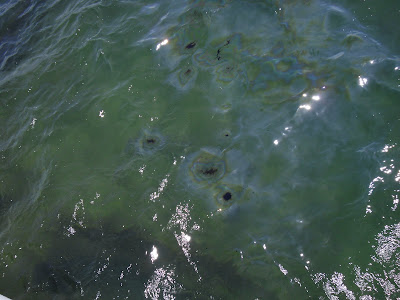Tuesday, August 9, 2011
Today, Jerry felt much better after taking the prescribed cocktail of antibiotics and steroids. We began our day driving out to Pearl Harbor and the memorial site of the USS Arizona. We purchased tickets and waited two hours for our tour to be taken to the memorial site.
 |
| Jerry and Michelle aboard the windy stern of the USS Bowfin. |
Using the self-guided audio tour, Michelle learned that one reason the U.S. submarines were so successful during the war was due to their ability to dive below Japanese radar range. Though we suspected life on a submarine must have been, in a word, tough, we didn't know just how tough until we were told of how the men on the sub experienced radio silence. It meant no talking, no sneezing, no coughing and no dropping anything, all in a super hot (the air conditioner made noise) metal container several hundred feet below the surface.
Video tour of the Bowfin!
After our tour of the Bowfin, we made our way to the dock for our ferry to take us over to the USS Arizona Memorial. Before boarding the ferry we were shown a short video on the history of the bombing at Pearl Harbor, which was only shown in English, despite the fact that Japanese tourists made up more than half the group. It was a little awkward hearing the American take on the war in the Pacific amidst so many Japanese viewers, but maybe that's why it wasn't subtitled?
Our ferry was captained by Navy officers, which we thought was a very cool job--shuttling tourists around all day. From the ferry, we could see markers for the other ships that were stationed there during the attack on Pearl Harbor. On our way over we learned that all but three of the 21 ships attacked that day were salvaged and used during the war--the Arizona, the Utah, and the Oklahoma.
 | ||||||||||||
| Entrance to the Memorial structure. |
From inside the memorial, one can see the top of the cannon turrets poking up through the water. Also, despite the 70 years that have passed, it is still possible to see oil leaking out of the Arizona from the ship's galley.
 |
| Scale model of the USS Arizona in Pearl Harbor Visitor's Center. |
After our ferry docked onshore, we visited some of the exhibits in the Pearl Harbor visitor's center. It contains several exhibit rooms detailing the events leading up to the attack in both the United States and Japan. There is also a separate room dedicated entirely to the attack itself. Within one of the rooms, Michelle noticed a copy of the speech FDR gave right after the attack, the "day that will live in infamy" speech. It appeared to be an original with FDR's notes scrawled on it (The word "infamy" was scribbled in by FDR himself). She later learned that she saw only a copy and that the original speech is actually housed at the National Archives, which is a 20-minute metro ride from our apartment.
On our way back to Waikiki we stopped at Mark's Drive Inn for our first plate lunch. We each ordered the loco moco, a local "specialty". Like all plate lunches, it was served with macaroni salad. The loco moco itself is a scoop of rice topped with one or two hamburger patties, brown gravy, and a fried egg (or two). The end result is an overload of protein and carbs that somehow works.
 |
| The "Loco Moco" at Mark's Drive Inn |
 |
| Mark's Drive Inn in Honolulu -- you know you're in an authentic Hawaiian joint if you're greeted by a stack of empty spam and mayo boxes near the front door. |
We arrived back at the hotel and decided to spend some time on Waikiki beach before dinner at Sansei that night. Luckily for us, the sun was fairly weak at that point and Jerry didn't begin suffering from his epic Hawaiian sunburn yet.
 | |
| Jerry and Michelle on Waikiki Beach. |
We then got ready for our dinner at Sansei seafood restaurant and sushi bar, which was highly recommended. Apparently, the people who had visited this place before had never had good sushi. We ordered edamame to start as we always do, and it came out cold and without salt. We each ordered an appetizer, Michelle had some lightly seared Walu with a light citrusy sauce, which was actually quite good. Jerry and Michelle selected five rolls off of the sushi menu eagerly anticipating delicious fresh Hawaiian fish. What we got was sushi crafted with long grain rice that fell apart when we tried to pick them up. We've had better sushi from Whole Foods, in Virginia. It was pretty sad and we're still disappointed.



